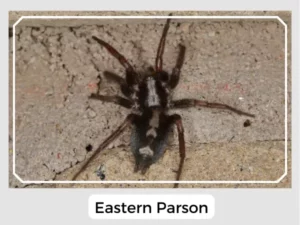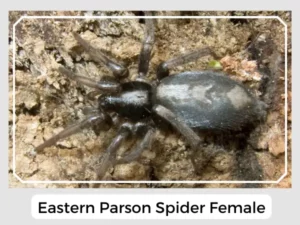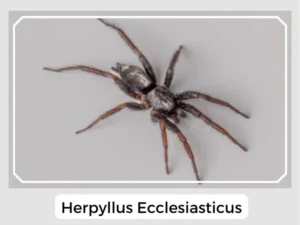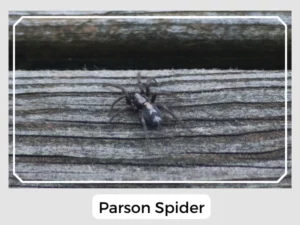The eastern parson spider is a special kind of spider from the USA and Canada. It’s part of the Gnaphosidae family. Instead of making webs to catch food, this spider likes to chase down its meals! It’s a sneaky spider, hiding in soft spots during the day and hunting at night. We’ve got some cool facts to share about them right here!

Photo Credit: John Guerin
The female keeps the round egg sac containing around 3,000 eggs under the tree barks or carries herself during the fall and hibernates to protect the eggs. After a few weeks later, the eggs are hatched.
Nothing has been observed so far regarding juvenile spiders. They can overwinter in the sac.
Yes, Eastern Parson spiders have venom. They use it to catch the bugs they eat. But for people, it’s not very strong.
They can bite if they’re disturbed. It might feel like a tiny pinch, but it’s usually not a big deal for most folks.

Photo Credit: Seth Ausubel
The Eastern Parson Spider plays a crucial role in maintaining the balance of ecosystems it inhabits. By preying on various insects, it helps control their populations, ensuring that no single species dominates. This nocturnal hunter relies on its agility and speed to chase down and capture its prey, exhibiting a behavior that is as fascinating as it is important for the ecological balance.
Natural Predator: Despite its prowess as a hunter, the Eastern Parson Spider is not without its own predators. Birds, larger spiders, and other insectivorous animals prey on this spider, forming a complex web of life that underscores the interconnectedness of all species in an ecosystem.
Prey-Predator Dynamics: The Eastern Parson Spider has adapted to its environment in such a way that it both contributes to and benefits from the delicate balance of its ecosystem. Its role as both predator and prey is a testament to the complexity of ecological relationships and the importance of each species, no matter how small, in maintaining the health and stability of the environment.
Relationship with Humans: While the Parson Spider may seem intimidating due to its venomous nature, it is generally harmless to humans and can even be beneficial. By keeping insect populations in check, this spider indirectly contributes to human well-being, helping to create a more balanced and comfortable living environment. However, it is crucial for humans to reciprocate this relationship by protecting the habitats of these spiders and ensuring their conservation.

Photo Credit: David Illig
| Also Known as | Parson Spider |
| Distribution | Northern Carolina, Alberta |
| Habitat | Under rocks and barks |
| Diet | Insects |
| Lifespan | 1-2 years |
| IUCN Conservation Status | Not listed |
In summary, from its impressive hunting skills and unique physical characteristics to its crucial role in the ecosystem, the Eastern Parson Spider is undoubtedly a remarkable species.

The eastern parson spider is a special kind of spider from the USA and Canada. It’s part of the Gnaphosidae family. Instead of making webs to catch food, this spider likes to chase down its meals! It’s a sneaky spider, hiding in soft spots during the day and hunting at night. We’ve got some cool facts to share about them right here!

Photo Credit: John Guerin
The female keeps the round egg sac containing around 3,000 eggs under the tree barks or carries herself during the fall and hibernates to protect the eggs. After a few weeks later, the eggs are hatched.
Nothing has been observed so far regarding juvenile spiders. They can overwinter in the sac.
Yes, Eastern Parson spiders have venom. They use it to catch the bugs they eat. But for people, it’s not very strong.
They can bite if they’re disturbed. It might feel like a tiny pinch, but it’s usually not a big deal for most folks.

Photo Credit: Seth Ausubel
The Eastern Parson Spider plays a crucial role in maintaining the balance of ecosystems it inhabits. By preying on various insects, it helps control their populations, ensuring that no single species dominates. This nocturnal hunter relies on its agility and speed to chase down and capture its prey, exhibiting a behavior that is as fascinating as it is important for the ecological balance.
Natural Predator: Despite its prowess as a hunter, the Eastern Parson Spider is not without its own predators. Birds, larger spiders, and other insectivorous animals prey on this spider, forming a complex web of life that underscores the interconnectedness of all species in an ecosystem.
Prey-Predator Dynamics: The Eastern Parson Spider has adapted to its environment in such a way that it both contributes to and benefits from the delicate balance of its ecosystem. Its role as both predator and prey is a testament to the complexity of ecological relationships and the importance of each species, no matter how small, in maintaining the health and stability of the environment.
Relationship with Humans: While the Parson Spider may seem intimidating due to its venomous nature, it is generally harmless to humans and can even be beneficial. By keeping insect populations in check, this spider indirectly contributes to human well-being, helping to create a more balanced and comfortable living environment. However, it is crucial for humans to reciprocate this relationship by protecting the habitats of these spiders and ensuring their conservation.

Photo Credit: David Illig
| Also Known as | Parson Spider |
| Distribution | Northern Carolina, Alberta |
| Habitat | Under rocks and barks |
| Diet | Insects |
| Lifespan | 1-2 years |
| IUCN Conservation Status | Not listed |
In summary, from its impressive hunting skills and unique physical characteristics to its crucial role in the ecosystem, the Eastern Parson Spider is undoubtedly a remarkable species.
